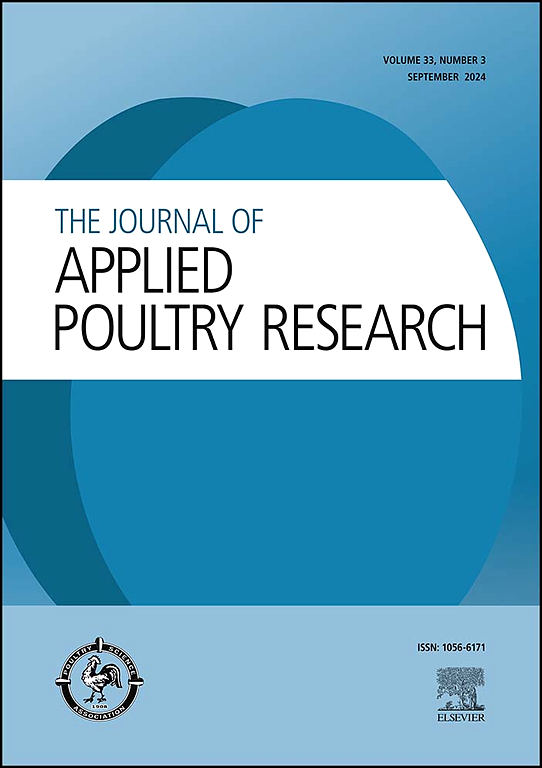Effect of different levels of tryptophan on laying performance, egg quality, blood and tibia parameters, and feather damage of laying hens in barn system
IF 2
3区 农林科学
Q2 AGRICULTURE, DAIRY & ANIMAL SCIENCE
引用次数: 0
Abstract
Animal welfare is a priority in the laying hen industry, with feather pecking being a major issue to address challenge. Feather pecking is a behavior derived from exploration and involves gently pecking the feathers of other hens. However, when pecking becomes severe, such as pecking or eating the feathers or tissues of others, it can lead to stress, decreased productivity, and even mortality. Studies have reported on a variety of methods to control these behaviors including nutrition, facilities, and management. L-tryptophan (TRP) is one of the essential amino acids and is a precursor to serotonin, a neurotransmitter known to control stress, aggression, and mood. The objective of this study was to investigate the effects of different supplementation levels of TRP on egg performance, stress parameters of blood, and welfare indices in laying hens. A total of 700 Hy-Line Brown layer, aged 70 weeks, were randomly assigned to four treatment groups. Each group fed a basal diet, based on maize and soybean meal, supplemented with 0.0 %, 0.25 %, 1.0 %, and 2.0 % TRP for 4 weeks. The addition of 0.25 and 1.0 % TRP were improved the hen-day egg production and egg mass compared to control group. Also, the level of corticosterone and serotonin in serum were positively affected by the 1.0 % TRP supplementation. Hens fed a diet with 1.0 % TRP resulted lower feather damage score than control. Furthermore, eggshell thickness improved with the addition of TRP to the diet. In conclusion, our findings suggest that supplementation with 1.0 % TRP may mitigate stress and improve egg production and welfare indices of laying hens in barn system
不同水平色氨酸对鸡舍体系蛋鸡产蛋性能、蛋品质、血液和胫骨参数及羽毛损伤的影响
动物福利是蛋鸡行业的优先事项,啄羽毛是解决挑战的主要问题。啄羽毛是一种源于探索的行为,包括轻轻地啄其他母鸡的羽毛。然而,当啄食变得严重时,比如啄食或吃掉别人的羽毛或组织,它会导致压力,生产力下降,甚至死亡。研究报告了多种控制这些行为的方法,包括营养、设施和管理。l -色氨酸(TRP)是一种必需氨基酸,是血清素的前体,血清素是一种控制压力、攻击性和情绪的神经递质。本试验旨在研究添加不同水平的色氨酸对蛋鸡产蛋性能、血液应激参数和福利指标的影响。选取70周龄海兰褐蛋鸡700只,随机分为4个治疗组。各组饲喂以玉米和豆粕为基础,在基础饲粮中添加0.0%、0.25%、1.0%和2.0%色氨酸的饲粮,为期4周。与对照组相比,添加0.25%和1.0%的色氨酸提高了母鸡日产蛋量和产蛋量。此外,血清中皮质酮和血清中5 -羟色胺的水平也受到1.0% TRP添加量的积极影响。饲粮中TRP含量为1.0%的母鸡羽毛损伤评分低于对照组。此外,蛋壳厚度随饲料中添加色氨酸而增加。综上所述,饲粮中添加1.0%的色氨酸可以缓解鸡舍系统中蛋鸡的应激,提高产蛋量和福利指数
本文章由计算机程序翻译,如有差异,请以英文原文为准。
求助全文
约1分钟内获得全文
求助全文
来源期刊

Journal of Applied Poultry Research
农林科学-奶制品与动物科学
CiteScore
4.10
自引率
10.50%
发文量
80
审稿时长
104 days
期刊介绍:
The Journal of Applied Poultry Research (JAPR) publishes original research reports, field reports, and reviews on breeding, hatching, health and disease, layer management, meat bird processing and products, meat bird management, microbiology, food safety, nutrition, environment, sanitation, welfare, and economics. As of January 2020, JAPR will become an Open Access journal with no subscription charges, meaning authors who publish here can make their research immediately, permanently, and freely accessible worldwide while retaining copyright to their work. Papers submitted for publication after October 1, 2019 will be published as Open Access papers.
The readers of JAPR are in education, extension, industry, and government, including research, teaching, administration, veterinary medicine, management, production, quality assurance, product development, and technical services. Nutritionists, breeder flock supervisors, production managers, microbiologists, laboratory personnel, food safety and sanitation managers, poultry processing managers, feed manufacturers, and egg producers use JAPR to keep up with current applied poultry research.
 求助内容:
求助内容: 应助结果提醒方式:
应助结果提醒方式:


